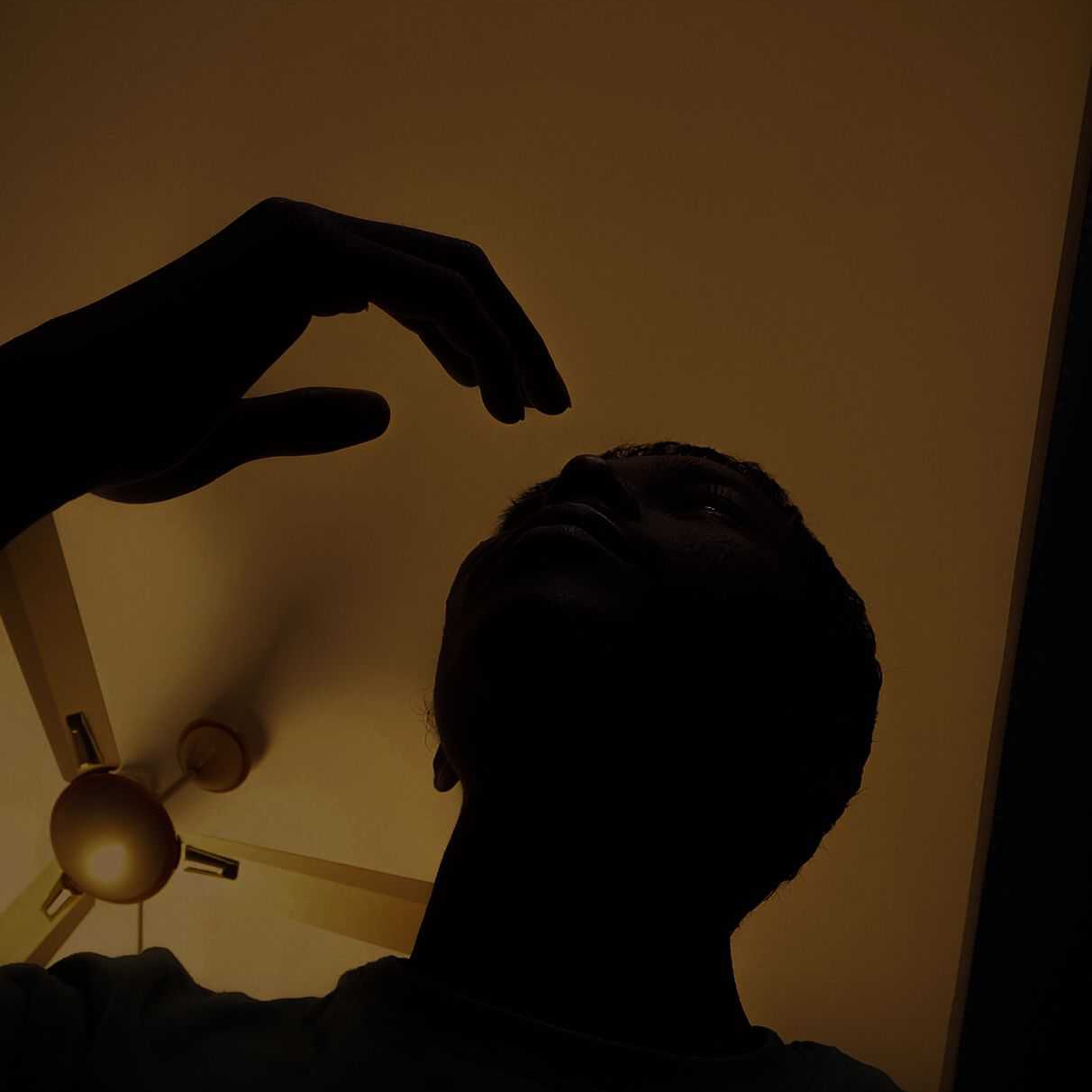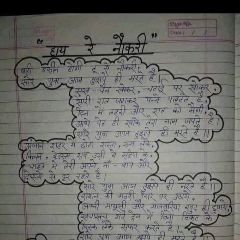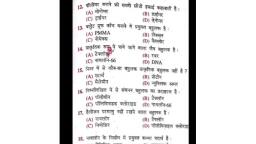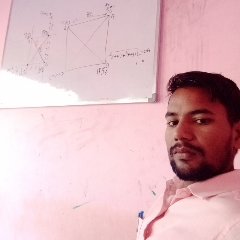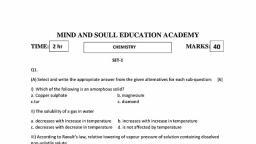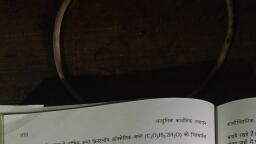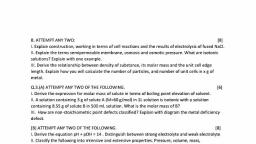Question 2 :
Which one of them is more ionic $LiCl$ or $NaCl$ ?
Question 3 :
A magnesium ion has a net positive charge while the magnesium atom has __________.
Question 4 :
An ionic bond A+ B- is most likely to be formed when :
Question 5 :
Which of the following sets of quantum numbers represents the highest energy of an atom?
Question 11 :
Which of the following ions have zero value of magnetic moment ?
Question 13 :
The attraction between molecules and salt, when a salt is dissolved in water molecules, is :
Question 15 :
A square planar complex is formed by hybridisation of which atomic orbitals?
Question 16 :
The structure of glycine (amino acid) is $H_{2}N-CH_{2}COO^{-}$ ($z$ witter ion). Select the correct statement:-
Question 21 :
The pair of elements most likely to form an ionic compound are :
Question 24 :
The ionic bonds $X^{\displaystyle+}Y^{\displaystyle-}$ are formed when<br>(I) electron affinity of $Y$ is high<br>(II) ionization energy of $X$ is low<br>(III) lattice energy of $XY$ is high<br>(IV) lattice energy of $XY$ is low
Question 27 :
The bond between hydrogen and fluorine in a molecule of hydrogen fluoride. $HF$ is sometimes considered an ionic bond and other times is considered a covalent bond.<br/>What is the reason for this confusion?
Question 29 :
Consider the given organometallic compound.<br>(I)$(CH_{3})_{2}\ Hg$ (II) $(CH_{3})_{2}\ Zn $ (III)$(CH_{3})_{2}\ Mg$ (IV)$CH_{3}Li$<br>The correct decreasing order of ionic character is :<br>
Question 31 :
Calcium oxide is formed as a result of transfer of _____ valence electrons.
Question 33 :
What is the effect of more electronegative atom on the strength of ionic bond?
Question 35 :
The electronic arrangements of four elements i, ii, iii, iv are:<br/>(i) $1 s^2$ (ii) $1s^22s^22p^2$ (iii) $1s^22s^22p^5$ (iv) $1s^22s^22p^6$<br/>The tendency to form ionic bond is maximum in:<br/>
Question 38 :
Assertion: Dinegative anion of oxygen $(O^{2-})$ is quite common but dinegative anion of sulphur $(S^{2-})$ is less common
Reason: Covalency of oxygen is two
Question 40 :
$HCl$ gas is covalent and $NaCl$ is an ionic compound. This is because:
Question 41 :
Ortho- Nitrophenol is less soluble in water than p- and m- Nitrophenols because :[2012]
Question 42 :
The Cl<sub>2</sub> molecules in crystalline chlorine are arranged in herring bone arrays within sheets, held together by covalent bonds. The shortest Cl to Cl distance within these sheets is 1.98 Å. Adjacent sheets are held together by vanderwaals forces and the closest approach between Cl atoms on neighbouring sheets is 3.69 Å. In solid HCl observed at lower temperatures , the H-Cl bond length is 1.25 Å. Therefore shortest distance between two Cl atoms in solid HCl is - (given vanderwaals radius of H = 1.1 Å)
Question 43 :
Which of the following compounds does not contain -1 formal charge on any of o atom :
Question 44 :
In which of the following reaction (s) H<sub>2</sub>SO<sub>4</sub> does not act as an acid as well as an oxidant ?
Question 45 :
Which types of bonds are present between two carbon atoms in acetylene molecule?
Question 46 :
Among the following species, which has the minimum bond length ?
Question 47 :
Which of following is the correct order of dipole moment ?<br><img style='object-fit:contain' src='https://storage.googleapis.com/teachmint/question_assets/JEE%20Main/5e7982bbd3f9ab617fcdb48c' height='75' width='95' ><img style='object-fit:contain' src='https://storage.googleapis.com/teachmint/question_assets/JEE%20Main/5e7982bbc6cb6261b35b2ab0' height='75' width='95' > <img style='object-fit:contain' src='https://storage.googleapis.com/teachmint/question_assets/JEE%20Main/5e7982bbadb2ea6185a762fd' height='75' width='95' ><br>(I) (II) (III)
Question 48 :
Which of the following sets of characteristics leads to the increase in solubility of ionic substances?
Question 50 :
Which of the following compounds of elements in group IV is expected to be most ionic ?
Question 51 :
Calculate the % of ionic character of a bond having length = 0.92 Å and 1.91 D as its observed dipole moment.
Question 55 :
Dipole moment of p- nitroaniline, when compared to nitrobenzene (X) and aniline (Y) will be-
Question 57 :
{tex} \ln \mathrm { P } _ { 4 } \mathrm { O } _ { 10 } {/tex} number of oxygen atoms attached to each phosphorus are
Question 58 :
Amongst LiCl, RbCl, BeCl<sub>2</sub> and MgCl<sub>2</sub> the compounds with greatest and least ionic character respectively are
Question 60 :
In which of the following species peroxide group is not present :
Question 61 :
An electrode connected to the positive terminal of a battery is called anode.
Question 63 :
<span class="wysiwyg-font-size-small"><span class="wysiwyg-font-size-small"></span></span><p class="wysiwyg-text-align-left">The EMF of a galvanic cell is determined by using a:</p>
Question 66 :
Which of the following condition is correct for operation of electrolytic cell?
Question 67 :
In a cell, the following reaction takes place: $Fe + CuSO_{4} \rightarrow FeSO_{4} + Cu$. The cell can be represented as:
Question 68 :
<span class="wysiwyg-font-size-small"><span class="wysiwyg-font-size-small"></span></span><p class="wysiwyg-text-align-left">In a galvanic cell, the reactions taking place in the anodic half cell and the cathodic half cell will be:</p>
Question 71 :
The electric conduction of a salt solution in water depends on the:
Question 72 :
Among $Na, Hg, S, Pt$ and graphite, which can be used as electrodes in electrolytic cells having aqueous solutions?
Question 75 :
$Zn(s)|ZnCl_2(aq)| |Cl^-(aq)|Cl_2(g)|C(s)$<br/>In the electrochemical cell described by the cell diagram above, what reaction occurs at the anode?<br/>
Question 76 :
<p class="wysiwyg-text-align-left"><span class="wysiwyg-font-size-small">$ Cu(S) + 2Ag^{+}(aq) \rightarrow Cu^{2+}(aq)+2Ag(S) $</span></p><span class="wysiwyg-font-size-small"><span class="wysiwyg-font-size-small"></span></span><p class="wysiwyg-text-align-left">In the given reaction, the reduction half cell reaction is:</p>
Question 77 :
In the silver plating of copper, K[Ag(CN)$_{2}$] is used instead of AgNO$_{3}$. The reason is:
Question 78 :
Statement 1: In an electrochemical cell, the electrode that is the site of reduction is called the anode.<br>Statement 2: Oxidation always occurs at the cathode.
Question 79 :
Which one of the following conditions will increase the voltage of the cell represented by the equation?<br>$Cu(s) + 2Ag^{+}(aq.) \rightleftharpoons Cu^{2+}(aq.) + 2Ag(s)$.
Question 80 :
KCl can be used in salt bridge as electrolyte in which of the following cells?
Question 81 :
What will be the emf of a cell of two hydrogen electrodes, if a negative electrode is in contact with $10^{-8}M\ H^+$ion positive electrode is in contact with $0.025M\ H^+$?
Question 82 :
Examine the following statement sand select the correct option.<br/>A : Electrolytic conduction is a physical change.<br/>B : In Electrolytic conduction, positive as well as negative ions conduct electricity.
Question 84 :
A very thin copper plate is electro-plated with gold using gold chloride in HCl. The current was passed for 20 minutes and the increase in the weight of the plate was found to be 2 gram [Au=197]. The current passed was:
Question 85 :
Given below are the half-cell reactions:<br/>${Mn}^{2+}+2{e}^{-}\rightarrow Mn;{E}^{o}=-1.18V$<br/>$2({Mn}^{+3}+{e}^{-}\rightarrow {Mn}^{2+});{E}^{o}=+1.51V$<br/>The ${E}^{o}$ for $3{Mn}^{2+}\rightarrow Mn+2{Mn}^{3+}$ will be:
Question 86 :
Which modifications are necessary to determine the resistance of solution by the usual method of measurements on Wheatstone's bridge principle?<br/>
Question 87 :
Which of the following reactions is correct for a given electrochemical cell at ${ 25 }^{ o }C$?<br/>$Pt\left| { Br }_{ 2 }\left( g \right) \right| { Br }^{ - }\left( aq \right) ||{ Cl }^{ - }\left( aq \right) \left| { Cl }_{ 2 }\left( g \right) \right| Pt$
Question 88 :
In a galvanic cell, the salt bridge<br>(i) does not participate chemically in the cell reaction<br>(ii) stops the diffusion of ions from one electrode to another<br>(iii) is necessary for the occurrence of the cell reaction<br>(iv) ensures mixing of the two electrolytic solutions.<br>
Question 89 :
Assertion: A saturated solution of KCl is used in making salt bridge.
Reason: Ionic mobilties of $K^{\oplus}$ and $Cl^{\ominus}$ are same.
Question 90 :
Which of the following statements are correct about voltaic cell?<br>(I) Chemical energy is converted into electrical energy.<br>(II) Electrons flow from anode to cathode.<br>(III) Oxidation occurs at anode.<br>(IV) Anode is negative and cathode is positive.
Question 91 :
The weight of the silver (atomic number: 108) displaced by a quantity of electricity which displaces 5600 ml of $O_2$ at STP will be:
Question 92 :
Fill in the blank with appropriate words.<br/>The electrolytic solution is always neutral because the total charge on $\underline{(i)}$ is equal to $\underline{(ii)}$ on $\underline{(iii)}$. Unlike the metallic conductor, the electrolyte conducts the electric current by virtue of movement of its $\underline{(iv)}$. The property due to which a metal tends to go into solution in term of positive ions is known as $\underline{(v)}$.<br/>(i), (ii), (iii), (iv) and (v) respectively are:<br/>
Question 96 :
The half cell involving the reaction $Cr_2O_7^{2-} (aq) + 14 H^+ (aq) + 6e \rightarrow 2Cr^{3+} (aq) + 7H_2O$ can be represented as :<br/>
Question 99 :
Which one is correct about a hypothetical electrochemical cell shown below?<br/>$\underset{A}{\ominus } | A^+ (XM) || B^+ (YM) | \underset{B}{\oplus} E_{cell} = + 0.20 V$<br/>
Question 100 :
In which of the following cases, conductivity decreases with an increase in temperature?
Question 101 :
Given the standard half-cell potentials $(E^o)$ of the following as<div><br/>$Zn=Zn^{2+}+2e^-$; $E^o=+0.76$V<br/>$Fe=Fe^{2+}+2e^{-}$; $E^o=+0.41$V<br/><br/><div>Then the standard e.m.f. of the cell with the reaction $Fe^{2+}+Zn\rightarrow Zn^{2+}+Fe$ is?<br/></div></div>
Question 102 :
The reaction taking place in the cell $Pt|\underset {1\ atm}{H_{2}(g)}|HCl(1.0\ M)|AgCl|Ag$ is:
Question 105 :
A solution containing one mole per litre of each $Cu(NO_3)_2$, $AgNO_3, Hg_2(NO_3)_2$ and $Mg(NO_3)_2$ is being electrolysed by using inert electrodes. The values of standard electrode potentials in volts(reduction potential) are.<br>$Ag^+/Ag=+0.80, Hg^{2+}_2/2Hg =+0.79$<br>$Cu^{2+}/Cu=+0.34, Mg^{2+}/Mg =-2.37$<br>With increasing voltage, the sequence of deposition of metals on the cathode will be:<br>
Question 106 :
In which of the following cells, use of salt bridge to eliminate liquid junction potential is not necessary?
Question 107 :
What will be $\Delta H$ for the reaction; $Ag(s)+\dfrac{1}{2}Hg_2Cl_2(s)\rightarrow AgCl(s)+Hg(l)$ at $25^0c$, if this reaction can be conducted in a cell for which the emf = 0.0455 volt at this temperature with temperature coefficient $3.389\times10^{-4} volt\, deg^{-1}$?
Question 108 :
A reaction:<div><br/>$\displaystyle \dfrac{1}{2}H_2(g)\, +\, AgCl(s)\, \rightleftharpoons\, H^{\oplus}(aq)\, +\, Cl^{\ominus} (aq)\, +\, Ag(s)$ occurs in a galvanic cell. </div><br/><div>The structure of the cell will be:</div>
Question 109 :
Given below are the half-cell reactions:<br/>$Mn^{2+} + 2e^- \to Mn; E^o = -1.18V$<br/>$2(Mn^{3+} + e^- \to Mn^{2+}); E^o = +1.51V$<br/>The $E^o$ for $3Mn^{2+} \to Mn +2Mn^{3+}$ will be:
Question 110 :
Amongst the following, the form of water with the lowest ionic conductance at $298 K$ is :
Question 112 :
Saturated solution $K{ NO }_{ 3 }$ is used to make salt bridge because:
Question 113 :
A galvanic cell is constructed using two Hydrogen electrodes. Emf is highest when the pH of the solutions at anode and cathode is _____ and ______ respectively.
Question 114 :
Consider a galvanic cell using solid $Cu$ and $Fe$ metals with their corresponding solutions.<br>What is the $E^{\circ}_{cell}$?<table class="wysiwyg-table"><tbody><tr><td>Standard Potential (V)</td><td>Reduction Half-Reaction</td></tr><tr><td>$2.87$</td><td>$F_{2}(g) + 2e^{-} \rightarrow 2F^{-}(aq)$</td></tr><tr><td>$1.51$</td><td>$MnO_{4}^{-}(aq) + 8H^{+}(aq) + 5e^{-}\rightarrow Mn^{2+}(aq) + 4H_{2}O(l)$</td></tr><tr><td>$1.36$</td><td>$Cl_{2}(aq) + 3e^{-} \rightarrow 2Cl^{-}(aq)$</td></tr><tr><td>$1.33$</td><td>$Cr_{2}O_{7}^{2-} (aq) + 14H^{+}(aq) + 6e^{-} \rightarrow 2Cr^{3+}(aq) + 7H_{2}O(l)$</td></tr><tr><td>$1.23$</td><td>$O_{2}(g) + 4H^{+}(aq) + 4e^{-}\rightarrow 2H_{2}O(l)$</td></tr><tr><td>$1.06$</td><td>$Br_{2}(l) + 2e^{-} \rightarrow 2Br^{-}(aq)$</td></tr><tr><td>$0.96$</td><td>$NO_{3}^{-}(aq) + 4H^{+}(aq) + 3e^{-}\rightarrow NO(g) + H_{2}O(l)$</td></tr><tr><td>$0.80$</td><td>$Ag^{+}(aq) + e^{-} \rightarrow Ag(s)$</td></tr><tr><td>$0.77$</td><td>$Fe^{3+} (aq) + e^{-} \rightarrow Fe^{2+}(aq)$</td></tr><tr><td>$0.68$</td><td>$O_{2}(g) + 2H^{+}(aq) + 2e^{-}\rightarrow H_{2}O_{2}(aq)$</td></tr><tr><td>$0.59$</td><td>$MnO_{4}^{-}(aq) + 2H_{2}O(l) + 3e^{-}\rightarrow MnO_{2}(s) + 4OH^{-}(aq)$</td></tr><tr><td>$0.54$</td><td>$I_{2}(s) + 2e^{-}\rightarrow 2I^{-}(aq)$</td></tr><tr><td>$0.40$</td><td>$O_{2}(g) + 2H_{2}O(l) + 4e^{-} \rightarrow 4OH^{-}(aq)$<br></td></tr><tr><td>$0.34$</td><td>$Cu^{2+}(aq) + 2e^{-} \rightarrow Cu(s)$</td></tr><tr><td>$0$</td><td>$2H^{+}(aq) + 2e^{-}\rightarrow H_{2}(g)$</td></tr><tr><td>$-0.28$</td><td>$Ni^{2+}(aq) + 2e^{-}\rightarrow Ni(s)$</td></tr><tr><td>$-0.44$</td><td>$Fe^{2+}(aq) + 2e^{-}\rightarrow Fe(s)$</td></tr><tr><td>$-0.76$</td><td>$Zn^{2+}(aq) + 2e^{-}\rightarrow Zn(s)$</td></tr><tr><td>$-0.83$</td><td>$2H_{2}O(l) + 2e^{-}\rightarrow H_{2}(g) + 2OH^{-}(aq)$</td></tr><tr><td>$1.66$</td><td>$Al^{3+}(aq) + 3e^{-}\rightarrow Al(s)$</td></tr><tr><td>$-2.71$</td><td>$Na^{+}(aq) + e^{-} \rightarrow Na(s)$</td></tr><tr><td>$-3.05$</td><td>$Li^{+}(aq) + e^{-}\rightarrow Li(s)$</td></tr></tbody></table>
Question 115 :
Saturated solution of $KNO_3$ is used to make ' salt-bridge' because:
Question 116 :
In dry cell the reaction which takes place at the zinc anode is:
Question 117 :
In an electrochemical cell, reduction takes place at anode BECAUSE oxidation always takes place at the cathode.
Question 118 :
<div> State True or False.<br/></div>The salt bridge permits movement of charge and mixing of the solution.<br/>
Question 119 :
The reaction,<br/><div> $(1/2) H_2 (g) + AgCl(s) = H^+ (aq) + Cl^- (aq) + Ag (s)$ occurs in the galvanic cell </div><br/><div> The correct cell representation is given by _____________.</div>
Question 120 :
Assertion: The conductivity of electrolytic solutions increases with increase of temperature.
Reason: Electronic conductance decreases with increase of temperature.
Question 121 :
Pure {tex} \mathrm { NH } _ { 3 } {/tex} is placed in a vessel at a temperature where its dissociation is appreciable. At equilibrium
Question 123 :
Consider the reaction equilibrium<br> {tex} 2 \mathrm { SO } _ { 2 } ( \mathrm { g } ) + \mathrm { O } _ { 2 } ( \mathrm { g } ) \rightleftharpoons 2 \mathrm { SO } _ { 3 } ( \mathrm { g } ) ; \Delta \mathrm { H } ^ { \circ } = - 198 \mathrm { kJ } {/tex}<br>On the basis of Le Chatelier's principle, the condition favourable for the forward reaction is<br>
Question 125 :
In which of the following reactions, increase in the volume at constant temperature does not affect the number of moles at equilibrium?
Question 126 :
For the reaction<br>{tex} 2 \mathrm { NO } _ { 2 ( \mathrm { g } ) } \rightleftharpoons 2 \mathrm { NO } _ { ( \mathrm { g } ) } + \mathrm { O } _ { 2 ( \mathrm { g } ) } {/tex} {tex} \left( K _ { c } = 1.8 \times 10 ^ { - 6 } \text { at } 184 ^ { \circ } \mathrm { C } \right) {/tex} {tex} ( R = 0.0831 \mathrm { kJ } / ( \mathrm { mol } \mathrm { K } ) ) . {/tex} When {tex} K _ { p } {/tex} and {tex} K _ { c } {/tex} are compared at {tex} 184 ^ { \circ } \mathrm { C } {/tex} it is found that
Question 127 :
Let the solubility of an aqueous solution of {tex} \mathrm { Mg } ( \mathrm { OH } ) _ { 2 } {/tex} be {tex} x {/tex} then its {tex} K _ { s p } {/tex} is
Question 128 :
The {tex} \mathrm { pK } _ { a } {/tex} of a weak acid, {tex} \mathrm { HA } {/tex}, is {tex}4.80{/tex}. The {tex} \mathrm { pK } _ { b } {/tex} of a weak base, {tex} \mathrm { BOH } {/tex} is {tex} 4.78{/tex}. The {tex} \mathrm { pH } {/tex} of an aqueous solution of the corresponding salt, {tex} \mathrm { BA } , {/tex} will be
Question 129 :
The equilibrium constant expression for a gas reaction is, {tex}\mathrm K _ {\mathrm C } = \frac { \left[ \mathrm { NH } _ { 3 } \right] ^ { 4 } \left[ \mathrm { O } _ { 2 } \right] ^ { 5 } } { [ \mathrm { NO } ] ^ { 4 } \left[ \mathrm { H } _ { 2 } \mathrm { O } \right] ^ { 6 } } {/tex}<br>The balanced chemical equation corresponding to this expression is<br>
Question 130 :
The equilibrium constant at {tex}298 \mathrm { K } {/tex} for a reaction {tex} A + B \rightleftharpoons {/tex} {tex} C + D {/tex} is {tex} 100 . {/tex} If the initial concentration of all the four species were {tex} 1\mathrm { M } {/tex} each, then equilibrium concentration of {tex} D ( \text { in mol } {/tex} {tex} \mathrm { L } ^ { - 1 } {/tex} ) will be :
Question 131 :
The solubility in water of a sparingly soluble salt {tex} \mathrm { AB } _ { 2 } {/tex} is {tex} 1.0 \times 10 ^ { - 5 } \mathrm { mol } \mathrm { L } ^ { - 1 } {/tex} . Its solubility product number will be
Question 132 :
Consider the reaction equilibrium: {tex} 2 \mathrm { SO } _ { 2 ( \mathrm { g } ) } + \mathrm { O } _ { 2 ( \mathrm { g } ) } \rightleftharpoons \mathrm { SO } _ { 3 ( \mathrm { g } ) } ; \Delta H ^ { \circ } = - 198 \mathrm { kJ } {/tex}. On the basis of Le Chatelier's principle, the condition favourable for the forward reaction is
Question 133 :
The equilibrium constant for the reaction \[ \mathrm { SO } _ { 3 } ( \mathrm { g } ) \rightleftharpoons \mathrm { SO } _ { 2 } ( \mathrm { g } ) + \frac { 1 } { 2 } \mathrm { O } _ { 2 } ( \mathrm { g } ) \]<br>is {tex} K _ { \mathrm { c } } = 4.9 \times 10 ^ { - 2 } {/tex} . The value of {tex} K _ { \mathrm { c } } {/tex} for the reaction \[ \begin{array} { l } { 2 \mathrm { SO } _ { 2 } ( \mathrm { g } ) + \mathrm { O } _ { 2 } ( \mathrm { g } ) \rightleftharpoons 2 \mathrm { SO } _ { 3 } ( \mathrm { g } ) } \end{array} \]<br> will be
Question 134 :
For the following three reactions {tex} a , b {/tex} and {tex} c , {/tex} equilibrium {tex} m {/tex} constants are given:<br>(i) {tex} \mathrm { CO } ( \mathrm { g } ) + \mathrm { H } _ { 2 } \mathrm { O } ( \mathrm { g } ) \rightleftharpoons \mathrm { CO } _ { 2 } ( \mathrm { g } ) + \mathrm { H } _ { 2 } ( \mathrm { g } ) ; \mathrm { K } _ { 1 } {/tex} <br>(ii) {tex} \mathrm { CH } _ { 4 } ( \mathrm { g } ) + \mathrm { H } _ { 2 } \mathrm { O } ( \mathrm { g } ) \rightleftharpoons \mathrm { CO } ( \mathrm { g } ) + 3 \mathrm { H } _ { 2 } ( \mathrm { g } ) ; \mathrm { K } _ { 2 } {/tex} <br>(iii) {tex} \mathrm { CH } _ { 4 } ( \mathrm { g } ) + 2 \mathrm { H } _ { 2 } \mathrm { O } ( \mathrm { g } ) \rightleftharpoons \mathrm { CO } _ { 2 } ( \mathrm { g } ) + 4 \mathrm { H } _ { 2 } ( \mathrm { g } ) ; \mathrm { K } _ { 3 } {/tex}<br>
Question 135 :
Conjugate acid of {tex} \mathrm { PO } _ { 4 } ^ { - 3 } {/tex} is
Question 136 :
For the reaction {tex} \mathrm { CO } ( \mathrm { g } ) + ( 1 / 2 ) \mathrm { O } _ { 2 } ( \mathrm { g } ) = \mathrm { CO } _ { 2 } ( \mathrm { g } ) , K _ { p } / K _ { c } {/tex} is
Question 137 :
For the equilibrium<br>{tex} \mathrm { CO } + \mathrm { H } _ { 2 } \mathrm { O } \rightleftharpoons \mathrm { CO } _ { 2 } + \mathrm { H } _ { 2 } {/tex}<br>The relation between {tex} \mathrm { K } _ { \mathrm { p } } {/tex} and {tex} \mathrm { K } _ { \mathrm { c } } {/tex} at {tex} 25 ^ { \circ } \mathrm { C } {/tex} and at {tex} 100 ^ { \circ } \mathrm { C } {/tex} are
Question 138 :
Hydrogen ion concentration in {tex} \mathrm { mol } / \mathrm { L } {/tex} in a solution of {tex} \mathrm { pH } = 5.4 {/tex} will be :
Question 140 :
For the reaction {tex} \mathrm { SO } _ { 2 ( g ) } + \frac { 1 } { 2 } \mathrm { O } _ { 2 ( g ) } \rightleftharpoons \mathrm { SO } _ { 3 ( g ) } , {/tex} if {tex} K _ { P } = K _ { C } ( R T ) ^ { x } {/tex} where the symbols have usual meaning then the value of {tex} x {/tex} is (assuming ideality):
Question 142 :
For which of the following reactions $K_p$ and $K_c$ are not same?
Question 143 :
The exothermic formation of {tex} \mathrm { CIF } _ { 3 } {/tex} is represented by the equation:<br>{tex} \mathrm { Cl } _ { 2 } ( \mathrm { g } ) + 3 \mathrm { F } _ { 2 } ( \mathrm { g } ) \rightleftharpoons 2 \mathrm { ClF } _ { 3 } ( \mathrm { g } ) ; \Delta \mathrm { H } = - 329 \mathrm { kJ } {/tex} <br>Which of the following will increase the quantity of {tex} \mathrm { CIF } _ { 3 } {/tex} in an equilibrium mixture of {tex} \mathrm { Cl } _ { 2 } , \mathrm { F } _ { 2 } {/tex} and {tex} \mathrm { ClF } _ { 3 } ? \quad [ 2005 \mathrm { I } ] {/tex}<br>
Question 144 :
For the equilibrium {tex} \mathrm { H } _ { 2 } \mathrm { O } ( \mathrm { s } ) \rightleftharpoons \mathrm { H } _ { 2 } \mathrm { O } ( \mathrm { l } ) {/tex} <br>which of the following statements is true?
Question 145 :
Solubility of {tex}\mathrm{AgCl}{/tex} in water, {tex}0.01 \mathrm{\ M}{/tex}{tex} \mathrm {\ CaCl } _ { 2 } , 0.01 \mathrm { M } {/tex} {tex}\mathrm{Nacl}{/tex} and {tex}0.05 \mathrm{\ M}\mathrm{\ AgNO}_ { 3 } {/tex} are {tex} \mathrm { S } _ { 1 } , \mathrm { S } _ { 2 } , \mathrm { S } _ { 3 } {/tex} and {tex} \mathrm { S } _ { 4 } {/tex} respectively, then,
Question 146 :
An amount of solid {tex} \mathrm { NH } _ { 4 } \mathrm { HS } {/tex} is placed in a flask already containing ammonia gas at a certain temperature and 0.50 atm pressure. Ammonium hydrogen sulphide decomposes to yield {tex} \mathrm { NH } _ { 3 } {/tex} and {tex} \mathrm { H } _ { 2 } \mathrm { S } {/tex} gases in the flask. When the decomposition reaction reaches equilibrium, the total pressure in the flask rises to 0.84 atm? The equilibrium constant for {tex} \mathrm { NH } _ { 4 } \mathrm {HS } {/tex} decomposition at this temperature is<br>
Question 148 :
Solid {tex} \mathrm { Ba } \left( \mathrm { NO } _ { 3 } \right) _ { 2 } {/tex} is gradually dissolved in a {tex} 1.0 \times 10 ^ { - 4 } \mathrm { M } {/tex} {tex} \mathrm { Na } _ { 2 } \mathrm { CO } _ { 3 } {/tex} solution. At what concentration of {tex} \mathrm { Ba } ^ { 2 + } {/tex} will a precipitate begin to form? {tex} \left( \mathrm { K } _ { \mathrm { SP } } \text { for } \mathrm { BaCO } _ { 3 } = 5.1 \times 10 ^ { - 9 } \right) {/tex}
Question 149 :
{tex} \left. \text { The molar solubility (in mol } \mathrm { L } ^ { - 1 } \right) {/tex} of a sparingly soluble salt {tex} \mathrm { MX } _ { 4 } {/tex} is 's' . The corresponding solubility product is {tex} K _ { s p } . \mathrm { 's } ^ { \prime } {/tex} is given in term of {tex} K _ { s p } {/tex} by the relation:
Question 150 :
{tex} \mathrm { 1M\ NaCl } {/tex} and {tex} \mathrm { 1M\ HCl } {/tex} are present in an aqueous solution. The solution is
Question 151 :
{tex} \mathrm { C } ( \mathrm { s } ) + \mathrm { H } _ { 2 } \mathrm { O } ( \mathrm { g } ) \rightleftharpoons \mathrm { H } _ { 2 } ( \mathrm { g } ) + \mathrm { CO } ( \mathrm { g } ) {/tex}<br>What will be the effect of pressure on the above equilibrium process?<br>
Question 153 :
In the reaction, {tex} A + B \rightleftharpoons C + D , {/tex} the equilibrium constant {tex} K {/tex} is determined by taking 1 mole of {tex} A {/tex} and 1 mole of {tex} B {/tex} as initial amounts. If 2 moles of {tex} A {/tex} and three moles of {tex} B {/tex} are taken, then the equilibrium constant will be
Question 154 :
How much water in {tex} \mathrm { mL } {/tex} must be added to {tex} 300 \mathrm { mL } {/tex} of {tex} 0.2 \mathrm { M } {/tex} solution of {tex} \mathrm { CH } _ { 3 } \mathrm { COOH } \left( \mathrm{K _ { a } = 1.8 \times 10 ^ { - 5 }} \right) {/tex} for the degree of ionisation {tex} \mathrm {( \alpha )} {/tex} of the acid to Triple.
Question 156 :
What is the conjugate base of {tex} \mathrm { OH } ^ { - } ? {/tex}
Question 157 :
The pH of a saturated aqueous solution of {tex} \mathrm { CO } _ { 2 } {/tex} is {tex} 5 ; {/tex} For {tex} \mathrm { H } _ { 2 } \mathrm { CO } _ { 3 } , \mathrm {K a _ { 1 }} = 10 ^ { - 7 } {/tex} and {tex} \mathrm{K a _ { 2 }} = 10 ^ { - 11 } . {/tex} At the given pressure the solubility of {tex} \mathrm { CO } _ { 2 } {/tex} in water is {tex} 10 ^ { - 2 } ( \mathrm { M } ) . {/tex} What is the value of {tex} - \log \left[ \mathrm { CO } _ { 3 } ^ { 2 - } \right] {/tex} in the nearest posssible integers?
Question 158 :
The {tex} \mathrm { pK } _ { a } {/tex} of a weak acid {tex} ( \mathrm { H } A ) {/tex} is {tex} 4.5 . {/tex} The pOH of an aqueous bufferd solution of {tex} \mathrm { HA } {/tex} in which {tex} 50 \% {/tex} of the acid is ionized is
Question 159 :
To {tex} 250.0 \mathrm { \ ml } {/tex} of {tex} \mathrm { \ M } / 50 \mathrm { H } _ { 2 } \mathrm { SO } _ { 4 } , {/tex} {tex} 4.0 \mathrm { g } {/tex} of solid {tex} \mathrm { NaOH } {/tex} is added and the resulting solution is diluted to {tex} 1.0 \mathrm {\ L } {/tex}. The pH of the resulting solution is
Question 160 :
Concentration of {tex} \left[ \mathrm { H } ^ { + } \right] {/tex} will decrease on mixing which of the following salts with the solution of acetic acid?
Question 161 :
The solubility in water of a sparingly soluble salt {tex} A B _ { 2 } {/tex} is {tex} 1.0 \times 10 ^ { - 5 } \mathrm { mol } \mathrm { L } ^ { - 1 } {/tex}. Its solubility product will be
Question 162 :
1 M NaCl and 1 M HCl are present in an aqueous solution. The solution is
Question 163 :
{tex}\mathrm{pH}{/tex} of {tex}\mathrm {Ba(OH)}{/tex} solution is {tex} 12 . {/tex} Its solubility product is
Question 164 :
In a saturated solution of the sparingly soluble strong electrolyte {tex} \left. \mathrm { AgIO } _ { 3 } \text { (molecular mass } = 283 \right) {/tex} the equilibrium which sets in is <br> {tex} \mathrm { AgIO } _ { 3 ( s ) } \rightleftharpoons \mathrm { Ag } ^ { + } ( \mathrm { aq } ) + \mathrm { IO } _ { 3 } ^ { - } ( \mathrm { aq } ) . {/tex} If the solubility product constant {tex} K _ { s p } {/tex} of {tex} A g I O _ { 3 } {/tex} at a given temperature is {tex} 1.0 \times 10 ^ { - 8 } , {/tex} what is the mass of AgIO {tex} _ { 3 } {/tex} contained in {tex}100 \mathrm { ml } {/tex} of its saturated saolution?<br>
Question 166 :
<font> What will be the pOH of 0.5 × 10</font><sup><font>-4</font></sup><font> M H</font><sub><font>2</font></sub><font>SO</font><sub><font>4</font></sub><font> solution -</font></p>
Question 167 :
<font>A pair of salts are given in a solution each in 0.1M concentration. Which solution has a higher pH ?</font></p>
Question 168 :
<font> 1 M NaCl and 1 M HCl are present in an aqueous solution. The solution is </font></p>
Question 169 :
<font> One litre of solution contains 10-5 moles of H+ ions at 25</font><sup><font>0</font></sup><font>C. Percentage ionisation of water in solution is :</font></p>
Question 170 :
<font>How many moles of NaOH must be removed from one litre of aqueous solution to change its pH from 12 to 11 ?</font></p>
Question 171 :
<font> When 0.1 mole solid NaOH is added in 1lt of 0.1 M NH3(aq) then which statement is wrong? <br/> (Kb = 2 × 10-5, log 2 = 0.3)</font></p>
Question 172 :
<font>In which of the following cases [H</font><sub><font>2</font></sub><font>O] can not be omitted ?</font></p>
Question 173 :
<font>At certain temperature K</font><sub><font>w</font></sub><font> for water 4 × 10</font><sup><font>-14</font></sup><font> which of the following is incorrect for pure water at the given temperature ?</font></p> <p align="justify"> <font>log 2 = 0.3</font></p>
Question 174 :
<font> The solubility of Mg(OH)2 is s moles/litre. The solubility product under the same condition is</font></p>
Question 175 :
<font> The buffer capacity of a given acid buffer solution is 100. To the solution if 0.5 moles of alkali is added, then</font></p>
Question 176 :
<font>To make a solution of pH = 12, the amount of NaOH dissolved in one litre of the solution should be -</font></p>
Question 177 :
<font>In aqueous solution the ionization constants for carbonic acid are</font></p> <p align="justify"> <font>K1 = 4.2 × 10-7 and K2 = 4.8 × 10-11</font></p> <p align="justify"> <font>Select the correct statement for a saturated 0.034 M solution of the carbonic acid.</font></p>
Question 178 :
<font>SThe pKa of a weak acid (HA) is 4.5. The pOH of an aqueous buffered solution of HA, in which 50% of the acid is ionized, is : </font></p>
Question 179 :
<font>When rain is accompanied by a thunderstorm, the collected rain water will have a pH value.</font></p>
Question 180 :
<font> The solubility product of AgCl is 1.8 × 10-10. Precipitation of AgCl will occur only when equal volumes of solutions of</font></p>
Question 181 :
<font> The pH of which salt is independent of its concentration :</font></p> <p align="justify"> <font>1. (CH3COO)C5H5NH</font></p> <p align="justify"> <font>2. NaH2PO4 </font></p> <p align="justify"> <font>3. Na2HPO4 </font></p> <p align="justify"> <font>4.NH4CN</font></p>
Question 182 :
<font>The solubility of a sparingly soluble salt Ax By in water at 25ºC = 1.4 × 10-4 M. The solubility product is 1.1 × 10-11. The possibilities are</font></p>
Question 183 :
<font>pH of a 1000 cc solution is 2. It will not change if -</font></p>
Question 184 :
<font>Consider an aqueous solution, 0.1 M each in HOCN, HCOOH, (COOH)2 and H3PO4, for HOCN, we can write Ka(HOCN) = </font> <img style='object-fit:contain' align="bottom" height="47" src="https://storage.googleapis.com/teachmint/question_assets/JEE%20Main/5fc0ebafe6377b2e815f40e6" width="88"/> <font>. [H+] in this expression refers to</font></p>
Question 185 :
<font>SThe solubility of CaF2 (Ksp = 3.4 × 10-11) in 0.1 M solution of NaF would be</font></p>
Question 186 :
Which one of the following groupings represents a collection of isoelectronic species ?{tex} ( \text { At. nos.: } \mathrm { Cs } : 55 , {/tex} {tex} \mathrm { Br } : 35 ) {/tex}
Question 187 :
If the value of En = - 78.4 kcal/mole, the order of the orbit in hydrogen atom is :
Question 188 :
The total number of electrons in a {tex} 4 \mathrm { d } {/tex} subshell are
Question 189 :
An electron in excited hydrogen atom falls from fifth energy level to second energy level. In which of the following regions, the spectrum line will be observed and is part of which series of the atomic spectrum?
Question 191 :
Splitting of spectral lines under the influence of magnetic field is called
Question 192 :
Fill in the blanks with appropriate words.<br>The principal quantum number n determines the __(i)__<br>And __(ii)__ of an orbital. With the increase in value of n, the number of allowed __(iii)___ increases. Azimuthal quantum number defines the __(iv)__ of the orbital. The number of subshells in a principal shell is equal to the value __(v)__<br>(i) (ii) (iii) (iv) (v)
Question 193 :
The correct set of quantum numbers for the unpaired electron of chlorine atom is
Question 194 :
According to Bohr's theory, the angular momentum of an electron in {tex} 5 ^ { \text {th } } {/tex} orbit is
Question 195 :
If threshold wavelength (λ°) for ejection of electron from metal is 330 nm, then work function for the photoelectric emission is -
Question 196 :
The numbers of d-electrons retained in Fe<sup>2+</sup> (atomic number Fe = 26) ion is
Question 197 :
How many electrons with {tex} I = 2 {/tex} are there in an atom having atomic number {tex} 54 ? {/tex}
Question 198 :
The energy required to break one mole of {tex} \mathrm { Cl } - \mathrm { Cl } {/tex} bonds in {tex} \mathrm { Cl } _ { 2 } {/tex} is {tex}242\ \mathrm { kJ } \mathrm { mol } ^ { - 1 } {/tex} . The longest wavelength of light capable of breaking a single {tex} \mathrm { Cl } - \mathrm { Cl } {/tex} bond is<br>{tex} \left( c = 3 \times 10 ^ { 8 } \mathrm { ms } ^ { - 1 } \text { and } N _ { A } = 6.02 \times 10 ^ { 23 } \mathrm { mol } ^ { - 1 } \right) {/tex}<br>
Question 200 :
Which of the following quantum numbers are correct for the outermost electron of sodium atom?
Question 202 :
Effective nuclear charge (<img style='object-fit:contain' src='https://storage.googleapis.com/teachmint/question_assets/JEE%20Main/5e78e3a2630b1e60d8656e17' height='21' width='33' >)for a nucleus of an atom is defined as.
Question 205 :
The frequency of a wave is 6 × 10<sup>15</sup> s<sup>-1</sup>. Its wave number would be
Question 206 :
In a multi-electron atom, which of the following orbitals described by the three quantum numbers will have the same energy in the absence of magnetic and electric field ?<br>(i) n = 1, l = 0, m = 0 (ii) n =2, l = 0, m = 0 (iii) n = 2, l = 1, m = 1 (iv) n = 3, l = 2, m =1 (v) n = 3, l = 2, m = 0
Question 207 :
The frequency of yellow light having wavelength 600 nm is -
Question 208 :
Uncertainity in position of a particle of 25 g in space is 10-15 m. Hence, Uncertainity in velocity (in m.sec-1) is : (plank's constant, h = 6.6 ´ 10-34Js)
Question 209 :
If proton, electron and α - particle have equal kinetic energy, their de-Broglie wavelengths would be in the order -
Question 210 :
Which atom (X) is indicated by the following configuration?<br><img style='object-fit:contain' src='https://storage.googleapis.com/teachmint/question_assets/JEE%20Main/5e78e36d0009445fe19ceb83' height='24' width='101' >
Question 211 :
An electron is moving in {tex} 3 ^ { \text {rd } } {/tex} orbit of hydrogen atom. The frequency of moving electron is
Question 212 :
If threshold wavelength (λ°) for ejection of electron from a metal is 330 nm, then work function for the photoelectric emission is
Question 213 :
The relationship between the dissociation energy of N<sub>2</sub> and N<sub>2</sub><sup>+</sup> is
Question 214 :
If the ratio of the radius of the two different nuclei is 2:3; then what will be the ratio of their mass? <div> (If density is same)</div>
Question 215 :
The radial distribution curve of the orbital with double dumbell shape in the fourth principle shell consists of {tex}'n'{/tex} nodes, {tex} n {/tex} is
Question 216 :
What is the wave length emitted during the transition of electron in between two levels of Li<sup>2+</sup> whose sum is 4 and difference is 2 ? Given R<sub>H</sub> = 109678 cm<sup>-1 </sup>:
Question 218 :
In the terms of Rydberg constant $R$, the wave number of the first Balmer line is :
Question 219 :
De-broglie wavelength associated with a ball (mass = $132$g) moving with speed of $1000 $ m/s is: <div>$(h= 6.6\times 10^{-34}$J-s$)$</div>
Question 220 :
If ${\lambda}_{0}$ and $\lambda$ be the threshold wavelength and the wavelength of incident light, the velocity of photoelectrons ejected will be:
Question 221 :
Assertion: On increasing the intensity of incident radiation, the photo electrons eject and their KE increases.
Reason: Greater the intensity means grater the energy which in turn means grater the frequency of the radiation.
Question 223 :
The ratio of slopes of ${ K }_{ max }$ vs $V$ and ${ V }_{ 0 }$ vs $v$ curves in the photoelectric effects gives: [$v=$ frequency, ${ K }_{ max }=$ maximum kinetic energy, ${ v }_{ 0 }=$ stopping potential]
Question 224 :
The velocity of an electron in the second stationary orbit of hydrogen atom is ?
Question 225 :
In astronomical observations signals observed from the distant stars are generally weak. If the photon detector receives a total of $3.15\times 10^{-18}$ J from the radiations of $600$ nm. Calculate the number of photons received by the detector.
Question 226 :
The experimental evidence for dual nature of matter comes from :
Question 227 :
In Rutherford's scattering experiment an α-particle is projected with K.E. = 4 MeV, minimum distance upto which this α-particle can reach to the nucleus of Cu nucleus- (atomic number of Cu = 29)
Question 228 :
The Vividh Bharti Station of All India Radio Delhi broadcasts on a frequency of $1,368\ kHz$. Calculate the wavelength $(\lambda)$ of the electromagnetic radiation emitted by the transmitter. Which part of the electromagnetic spectrum does it belong to?
Question 229 :
If the speed of electrons in Bohr's first obtain of hydrogen is $'X'$ the speed of electrons in third orbit is:
Question 230 :
The energy of a photon is given as $3.03\times 10^{-19}$ J/atom. The wavelength of the photon is :
Question 231 :
Particle nature and wave nature of electromagnetic waves and electrons can be represented by :
Question 232 :
The energy of second Bohr orbit of the hydrogen atom is $-328kJ\ { mol }^{ -1 }$. Hence, the energy of fourth Bohr orbit would be:
Question 233 :
The threshould frequency of a metal 'M' is 1.5 × 10<sup>15</sup> s<sup>-1</sup>. The maximum K.E. of the photoelectrons, when the metal is irradiated with radiations of frequecny 2.5 × 10<sup>15</sup> s<sup>-1</sup>, would be -
Question 234 :
Bohr's theory can also be applied to the ions like :
Question 235 :
A photon of $300nm$ is absorbed by a gas which then re-emits two photons. One re-emitted photon has wavelength $496nm$. Calculate wavelength of other photon re-emitted out as well as its energy.
Question 236 :
The reaction between $\displaystyle H_{2}$ and $Br_{2}$ to form $HBr$ in presence of light is initiated by the photo decomposition of $Br_{2}$ into free $Br$ atoms (free radicals) by absorption of light. The wavelength of $Br_{2}$ is: <div>[Given : $E=1240$ eV]<br/></div>
Question 238 :
An electron in hydrogen atom in its ground state absorbs energy equal to the ionisation energy of ${ Li }^{ 2+ }$. What will be the wavelength of emitted radiation, when electron returns to normal state?
Question 239 :
An alpha particle after passing through a potential difference of $2\times10^{6}$ volt falls on a silver foil. The atomic number of silver is 47. The K.E. of the $\alpha$-particle at the time of falling on the foil is:<br/>
Question 240 :
The ejection of the photoelectron from the silver metal in the photoelectric effect experiment can be stopped by applying a voltage of 0.35 V when the radiation 256.7 nm is used. Calculate the work function for silver metal.
Question 242 :
When the frequency of light incident on a metallic plate is doubled, the K.E of the emitted photoelectrons will be
Question 243 :
U.V. light of wavelength 800 A & 700 A falls on hydrogen atoms in their ground state & liberates electrons with kinetic energy 1.8eV and 4eV respectively, the Planck's constant is:<br/>
Question 244 :
In a photoelectric effect experiment, irradiation of a metal with light of frequency $5.2 \times {10}^{14} {sec}^{-1}$ yields electrons with maximum kinetic energy $1.3 \times {10}^{-19} J$. Calculate the ${v}_{0}$ of the metal.
Question 245 :
Ratio of energy of photon of wavelength $3000\overset{o}{A}$ and $6000\overset{o}{A}$ is : <br/>
Question 246 :
The Bohr orbit radius for the hydrogen atom (n = 1) is approximately 0.530Å. The radius for the first excited state (n = 2) orbit is (in Å)
Question 248 :
The photoelectric effect of Ba consists of emission of electrons from its ionisation energy on irradiation with light from the ionization energy of $He$-atom is irradiation with light. A photon with a minimum energy of $3.97\times 10^{-19}J$ is necessary to eject electron from $Ba$. <br>(a)What is the frequency of radiation corresponding to this value? <br>(b) Will a blue light of wavelength $450nm$ be able to eject at electron from $Ba$? (Given $h=6.626\times 10^{-27}erg-sec$)<br>
Question 249 :
The dissociation energy of $\displaystyle H_{2}$ is 430.53 KJ/mol. If $H_{2}$ is exposed to radiant energy of wavelength 253.7nm, what % of radiant energy will be converted into K.E?<br/>
Question 250 :
A photon of wavelength $4\times { 10 }^{ -7 } m$ strikes on metal surface. The work function of the metal is 2.13 eV. The velocity of the photo electron is:
